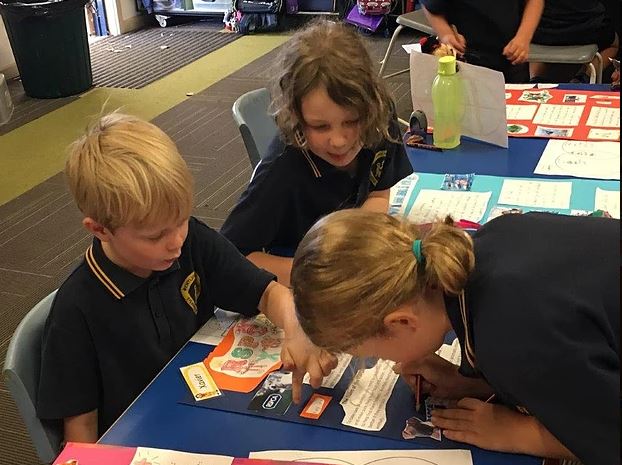Teaching consonant blends
Home » Phonics » Essential principles of systematic and explicit phonics instruction » Teaching consonant blends
Consonant blends, also referred to as adjacent consonants or consonant clusters, are composed of two or three consonant graphemes that precede or follow a vowel within a syllable, for example, st-op and str-ing have consonant blends at the beginning of the word, and ki-nd and unke-mpt have them at the end.
In a consonant blend each phoneme can be heard, whereas in a consonant digraph two or more consonants together represent a single phoneme such as ch, sh, tch, ph.
Consonant blends may also contain digraphs such as in shr-ill. The first phoneme is represented by the digraph sh and the second phoneme is represented by the grapheme r.

If students are being taught synthetic phonics, where stop sounds and continuous sounds are taught alongside phoneme blending and segmenting, we do not need to teach consonant blends as units. In synthetic phonics, students are taught to pay attention to each grapheme-phoneme correspondence from left to right and all through the word, so attention would be drawn to the individual nature of each of these grapheme-phoneme correspondences.
Louisa Moats (2010) reminds us, “Blends should not be described as one sound in phonics or spelling instruction”. If we try to teach blends as single sounds or units then we are increasing the amount of information students have to memorise.
There are 27 consonant clusters that come at the beginning of syllables (e.g. bl, str) and 49 consonant clusters that come at the end (e.g. nd, mpt), and only three of these occur in both positions (sk, sp, st).
There are approximately 176 common graphemes that children need to master to represent the 44 English phonemes, therefore adding blends as separate pieces of code knowledge adds more complexity (Eide, 2012). Furthermore, if we teach onset and rime chunks it adds hundreds more pieces of additional information that students do not need if they learn the extended alphabetic code.

Consonant blends are difficult for some children
This does not mean that we ignore blends when teaching reading. Consonant blends can be particularly tricky for beginning readers and here’s why.
Learning to read and spell is learning the code of our spoken language and how these map to letters and letter combinations. However when we speak, the sounds of our language are co-articulated. This means that they slide into one another so rapidly that sometimes they are difficult to discriminate in speech. It can depend on the following or preceding vowel, or the order of the word in a sentence. Say the phrase “best boy”. If you think about how you really say it in the flow of speech it will be pronounced like “bes boy”. In speech terms this is known as an elision.
Elisions present a problem for young students learning to spell as they make segmenting and isolating individual phonemes tricky. It also presents a problem for students who have weak phonemic awareness skills. Explicitly teaching and paying attention to the order of individual phonemes in blends, and the graphemes that represent them, is an important step in effectively teaching reading and spelling.
Tips for teaching consonant blends
Distinguishing voiced and unvoiced consonants is important for young readers especially when it comes to consonant clusters. Knowledge of voiced and unvoiced consonants will assist in the acquisition and understanding of grapheme-phoneme correspondences and minimise confusion surrounding consonant blends.
Blends that contain two continuous sounds such as sled, frog and snip do not usually present a difficulty for students.
Blends with stop consonants will require careful teaching and a considerable amount of practice compared to single consonant phonemes. Voiceless stop consonants are particularly problematic, for example sk, st, and sp. These are easily confused with their voiced counterpart, for example, stop may be segmented as s-d-o-p, or the second consonant not identified at all, i.e. s-o-p.
Further voiced and unvoiced confusion happens with blends containing /t/ and /d/ in combination with /r/, with ‘trees’ being identified as ch-ee-s or ‘drag’ segmented as j-r-a-g.
Ensuring teachers and students don’t articulate an unnecessary schwa with blends that contain stop consonants such as /b/ or /t/, can help to minimise students’ confusion. Inserting a schwa will result in the student segmenting blue as ‘buh-loo’ or trip as ‘tuh-rip”.
Limited phonological working memory can contribute to poor reading skills. Teaching blends as units or confusing voiced and unvoiced sounds only makes reading and spelling words with consonant blends more problematic for students with phonemic awareness and/or working memory difficulties.
Teachers must be aware of the challenges associated with teaching consonant blends so they can assist their students who find them more challenging. For many students, particularly those who make slow progress, consonant clusters will require plenty of explicit teaching and targeted practice. Teaching consonant clusters as units does not help these students all.
